LASER VAPING!
The image above shows the green light from a cheap
laser pointer focused on some ethanol-extracted 'concentrate.' The focused light
is copiously evaporating the concentrate into a smoke-like aerosol. The laser
cost $22 and came, free shipping, from China. It is more powerful than
most laser pointers, perhaps with more than 20 times the power of older style
laser pointers. If you put your hand at the focal point, you will feel it!
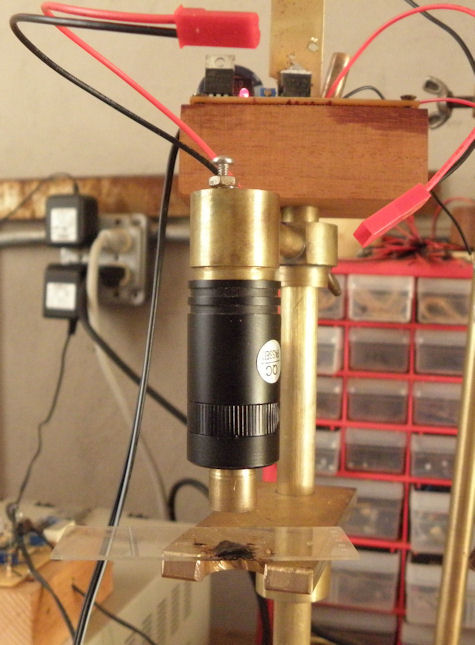 Here's the laser
fixture, with a circuit controls the electrical voltage and power (and the
brightness) of the beam. (Click on the image
for a larger view.) A laser microscope had been my goal, but then a friend said
laser microscopes were
already on YouTube so, just for the
heck of it, I tried focusing the energy into some concentrate. Check out this
short video of the aerosol "vapor" being produced
by the focused laser beam.
Here's the laser
fixture, with a circuit controls the electrical voltage and power (and the
brightness) of the beam. (Click on the image
for a larger view.) A laser microscope had been my goal, but then a friend said
laser microscopes were
already on YouTube so, just for the
heck of it, I tried focusing the energy into some concentrate. Check out this
short video of the aerosol "vapor" being produced
by the focused laser beam.
The lens that focuses the light is from an old
digital camera; it's affixed in front of (bottom of, in the image) the pointer,
i.e., where the beam ordinarily
comes out of the pointer.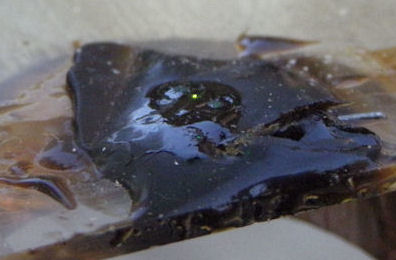 If the power to the laser is cut
way down, then the tightness of the focus of the beam can easily be seen, as here.
The dark tarry spot of 'concentrate' is about 1 centimeter wide (in the direction of
the edge of the glass slide). I estimate the diameter of the focused spot of is less
than 100 microns, i.e., less than 1/10th of a millimeter (<~0.004 inch).
If the power to the laser is cut
way down, then the tightness of the focus of the beam can easily be seen, as here.
The dark tarry spot of 'concentrate' is about 1 centimeter wide (in the direction of
the edge of the glass slide). I estimate the diameter of the focused spot of is less
than 100 microns, i.e., less than 1/10th of a millimeter (<~0.004 inch).
The photo at the top of this page shows the beam operating
at near full power. The image here, right, shows the laser pointer's label, which says
the power of the beam is <200 mW, which means it's some where less than 200 milliwatts.
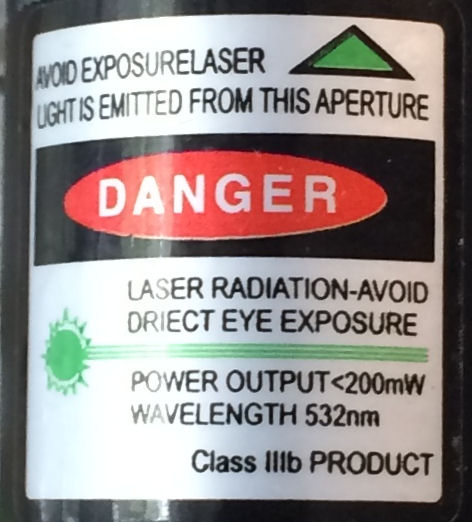 It's obviously more powerful than the usual laser pointer,
but there's no way of knowing its actual power output without measuring it.
Sellers of these things tend to exaggerate the power output of their lasers, sometimes
by a factor of 10 or more, I think. I control this laser's output by varying the
voltage across the laser diode. Full voltage I assume to be that of a fully charged
lithim-ion cell, which is the usual power source for this pointer, about 4.2 volts.
The laser begins producing visible output at about 2.2 volts. Production of "vapor"
(i.e., aerosol) becomes evident at as low as 2.8 volts. I haven't measured the
laser's power output as a function of voltage; I suspect the power is not linear with
voltage. At 2.8 volts, the power might be 80 percent of maximum, but I don't know,
yet.
It's obviously more powerful than the usual laser pointer,
but there's no way of knowing its actual power output without measuring it.
Sellers of these things tend to exaggerate the power output of their lasers, sometimes
by a factor of 10 or more, I think. I control this laser's output by varying the
voltage across the laser diode. Full voltage I assume to be that of a fully charged
lithim-ion cell, which is the usual power source for this pointer, about 4.2 volts.
The laser begins producing visible output at about 2.2 volts. Production of "vapor"
(i.e., aerosol) becomes evident at as low as 2.8 volts. I haven't measured the
laser's power output as a function of voltage; I suspect the power is not linear with
voltage. At 2.8 volts, the power might be 80 percent of maximum, but I don't know,
yet.
NOTES ON PHYSICAL PROPERTIES OF "WAX"
A friend in Baltimore gave me some "wax," which also goes
by the name "shatter" and various other names though, generically, it is 'concentrate.'
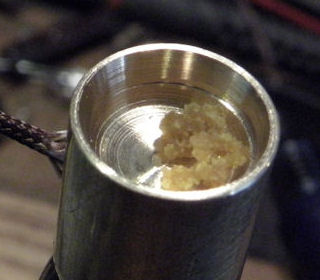 The black ethanol-extracted material used above with the laser
one form of concentrate. This "wax" shown here might be, but one hardly knows for
sure about these things, butane-extracted concentrate. Whatever it is, it it
yellow-greenish, like earwax, mine, at least, and with similar consistency but a nicer
smell. (The brass bowl it is shown in has a diameter of about 1.2 cm at the top. The
laser can melt it, but this "wax" is too reflective of green light to get evaporated.
The black ethanol-extracted material used above with the laser
one form of concentrate. This "wax" shown here might be, but one hardly knows for
sure about these things, butane-extracted concentrate. Whatever it is, it it
yellow-greenish, like earwax, mine, at least, and with similar consistency but a nicer
smell. (The brass bowl it is shown in has a diameter of about 1.2 cm at the top. The
laser can melt it, but this "wax" is too reflective of green light to get evaporated.
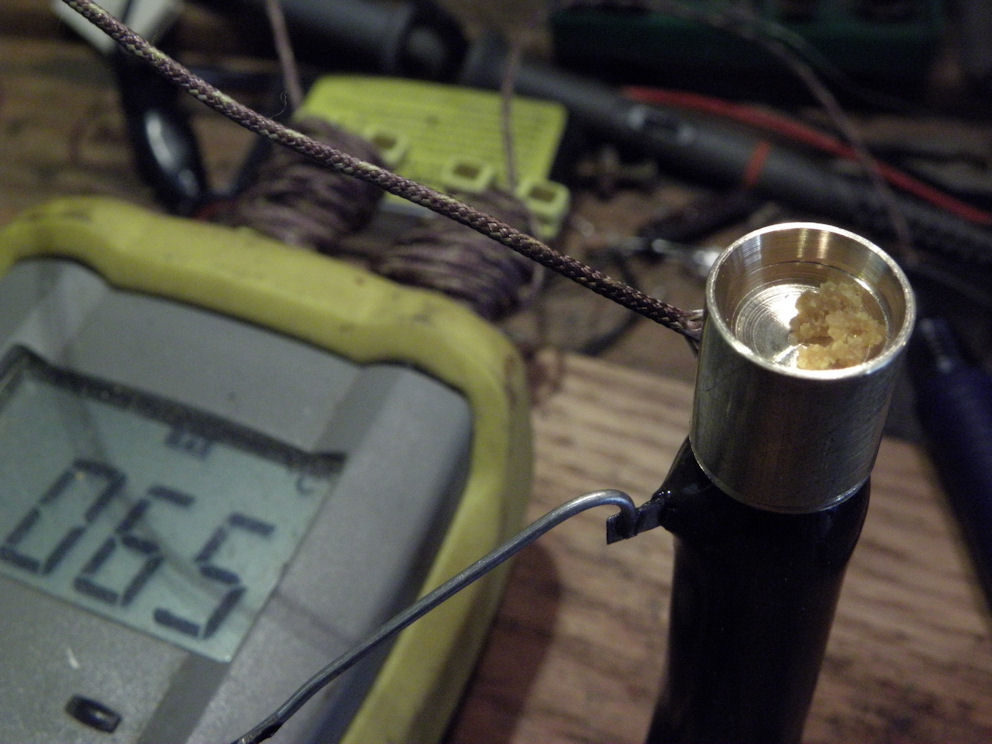 To determine wax's melting
temperature and vaporizing temperature, I made this brass bowl, which is heated
with a resistor. I used a digital thermometer to measure the temperatures. Here it is
at 65C (150F), still solid. (Click on the image for a larger view.)
To determine wax's melting
temperature and vaporizing temperature, I made this brass bowl, which is heated
with a resistor. I used a digital thermometer to measure the temperatures. Here it is
at 65C (150F), still solid. (Click on the image for a larger view.)
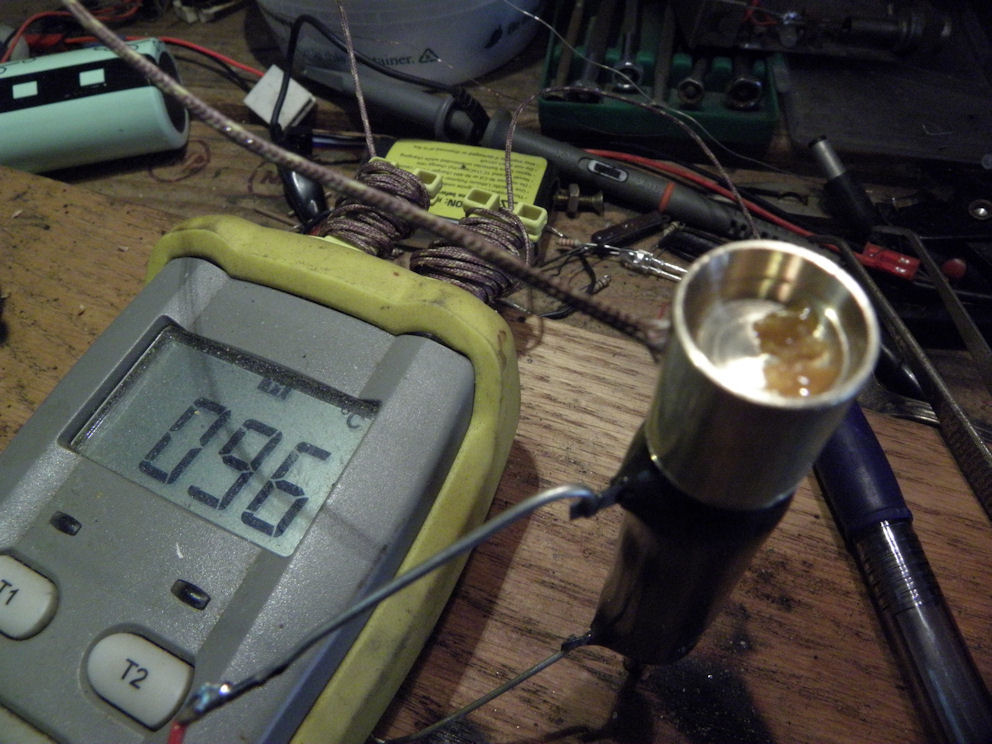 Here it is beginning
to melt at 96C:
Here it is beginning
to melt at 96C:
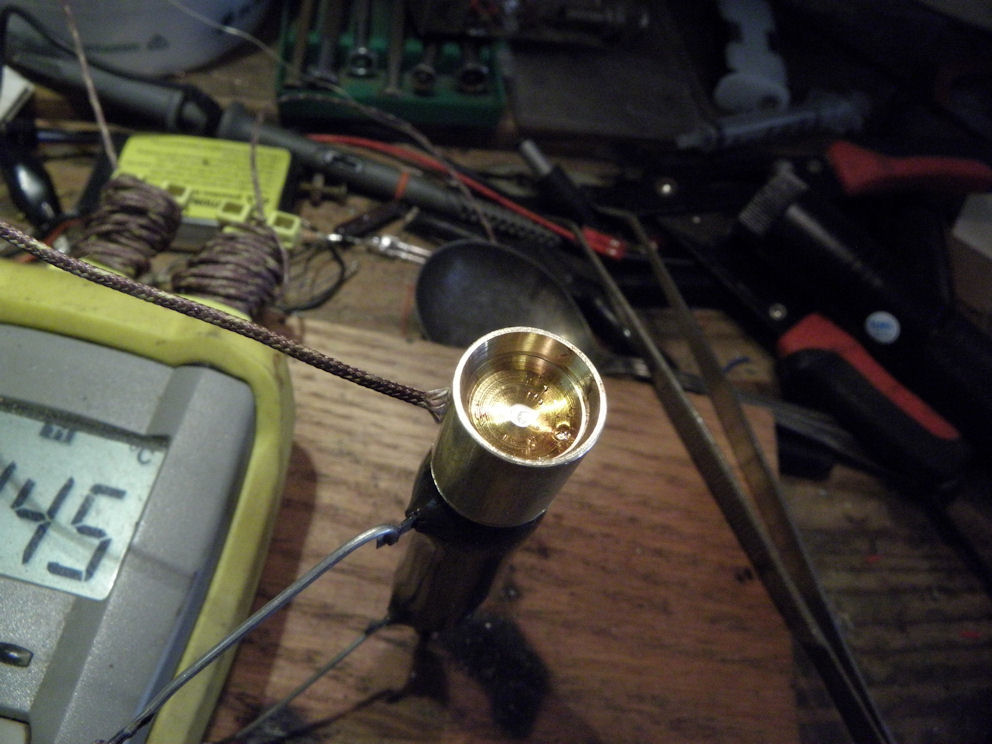 Gas bubbles seem to be
coming out of solution at 145C. The bubbles might be dissolved solvent
such as butane coming out of solution:
Gas bubbles seem to be
coming out of solution at 145C. The bubbles might be dissolved solvent
such as butane coming out of solution:
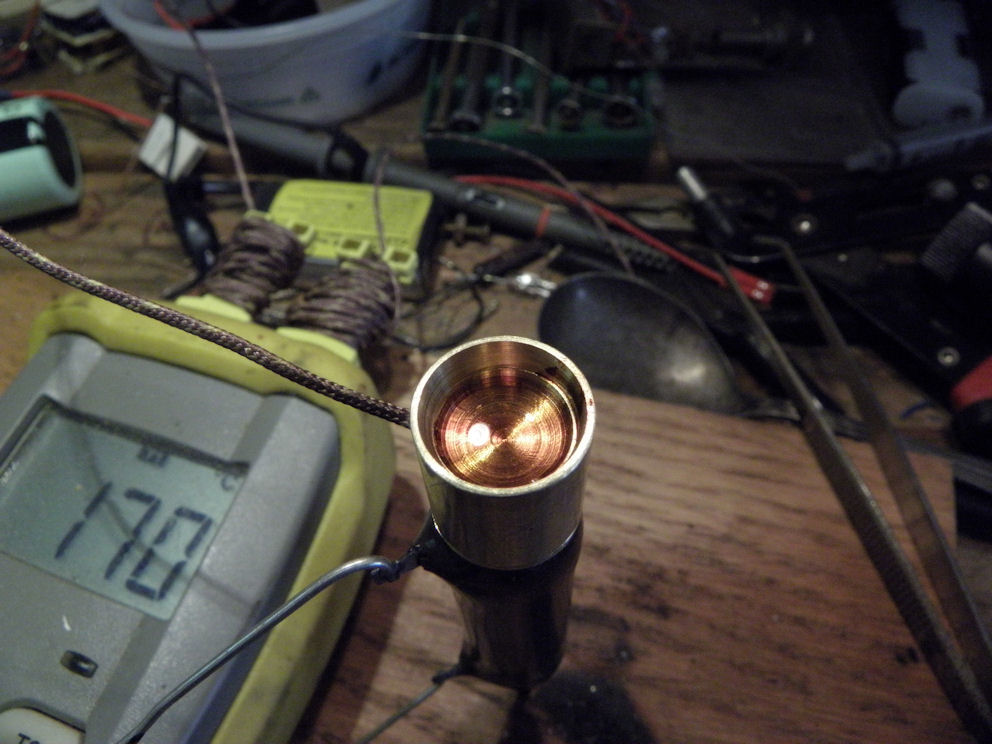 The melted "wax" began
to darken around 160C to 170C:
The melted "wax" began
to darken around 160C to 170C:
 Visible aerosol "vapor"
began coming off at around around 190C:
Visible aerosol "vapor"
began coming off at around around 190C:
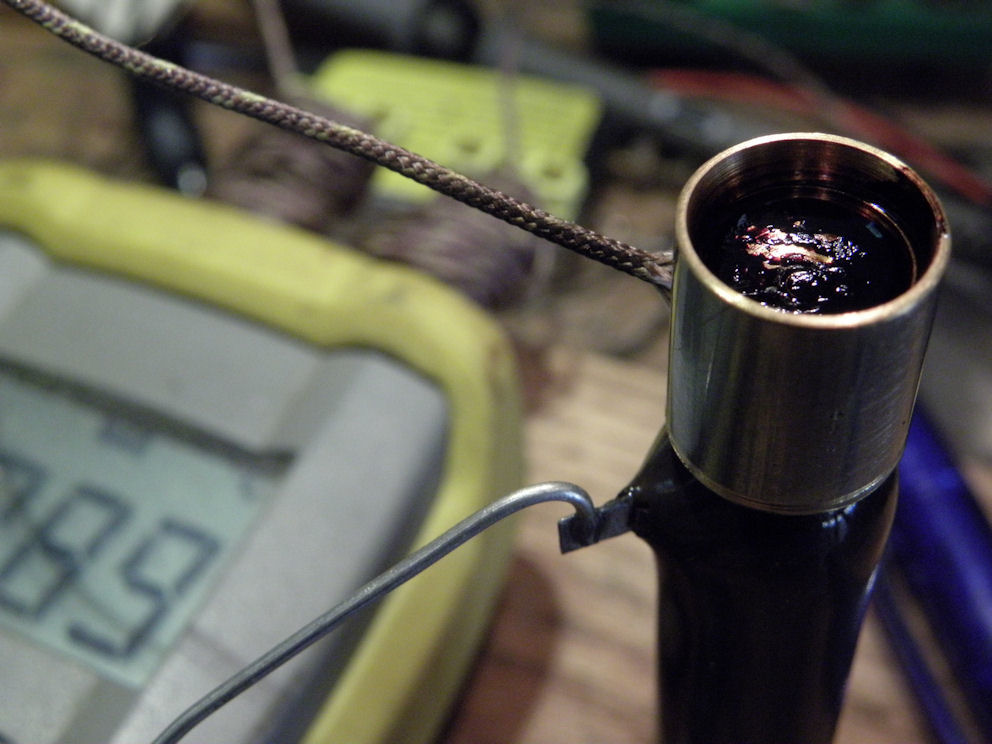 The stuff got
darker and darker as temperature increased. At 264C it looked like molasses.
Visible aerosol "vapor" began to taper off at ~285C. At 289C, I "scratched" the
thich and hardening dark residue, as shown here:
The stuff got
darker and darker as temperature increased. At 264C it looked like molasses.
Visible aerosol "vapor" began to taper off at ~285C. At 289C, I "scratched" the
thich and hardening dark residue, as shown here:
Bob
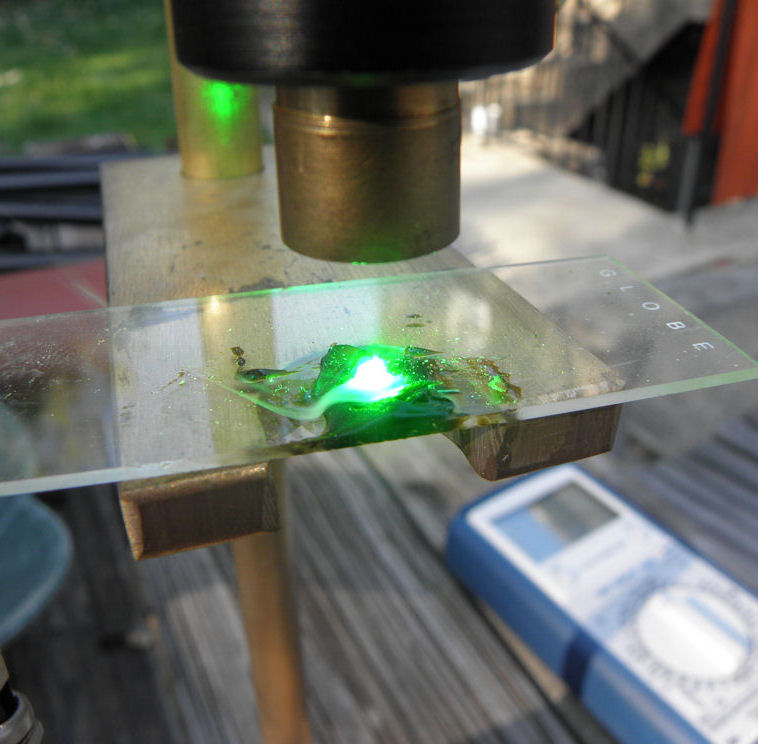



 The black ethanol-extracted material used above with the laser
one form of concentrate. This "wax" shown here might be, but one hardly knows for
sure about these things, butane-extracted concentrate. Whatever it is, it it
yellow-greenish, like earwax, mine, at least, and with similar consistency but a nicer
smell. (The brass bowl it is shown in has a diameter of about 1.2 cm at the top. The
laser can melt it, but this "wax" is too reflective of green light to get evaporated.
The black ethanol-extracted material used above with the laser
one form of concentrate. This "wax" shown here might be, but one hardly knows for
sure about these things, butane-extracted concentrate. Whatever it is, it it
yellow-greenish, like earwax, mine, at least, and with similar consistency but a nicer
smell. (The brass bowl it is shown in has a diameter of about 1.2 cm at the top. The
laser can melt it, but this "wax" is too reflective of green light to get evaporated. 



